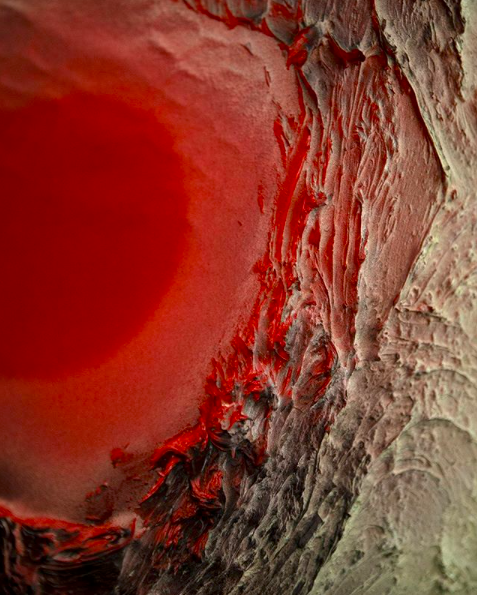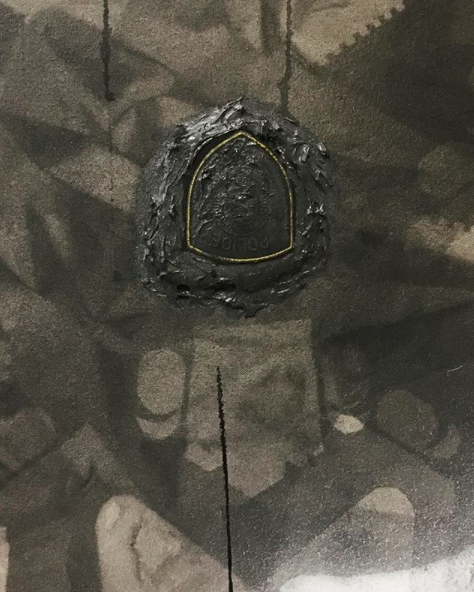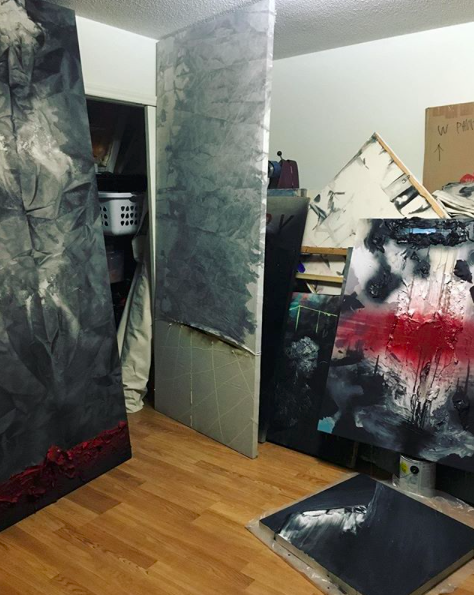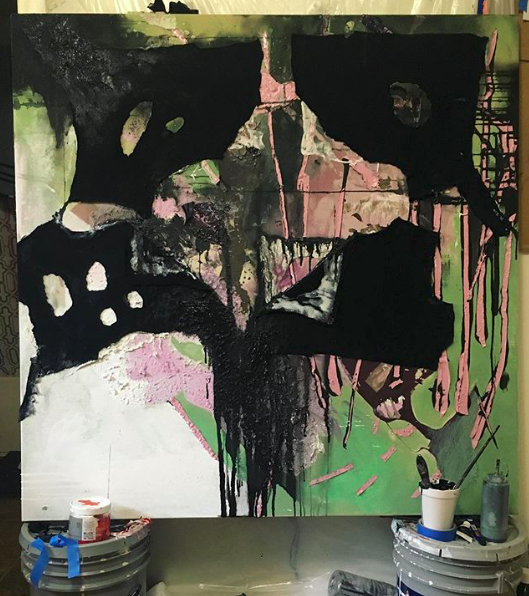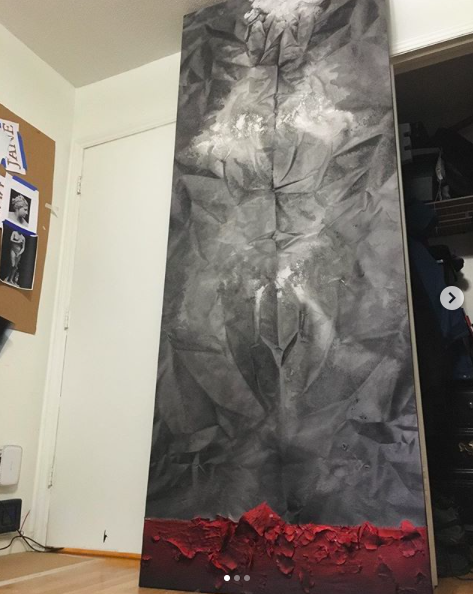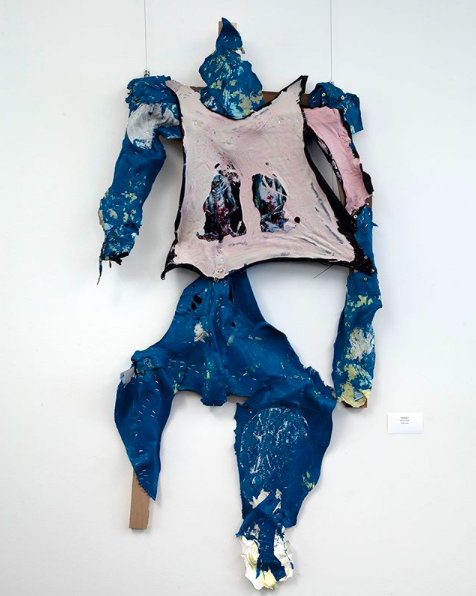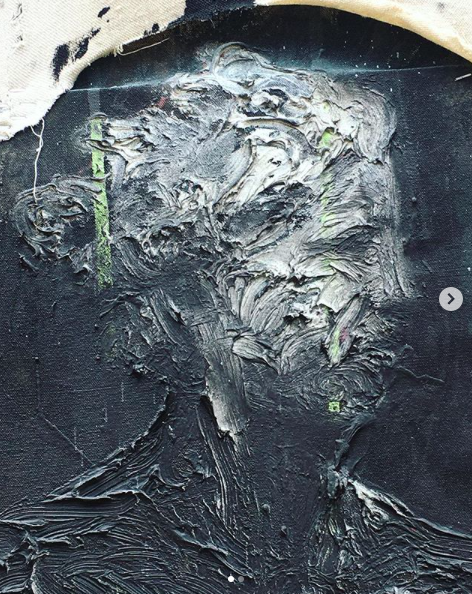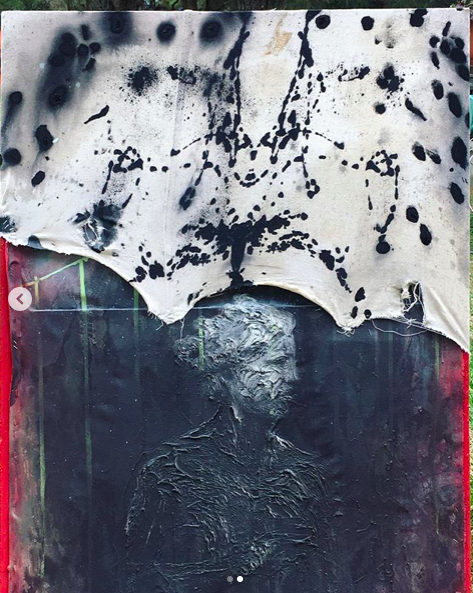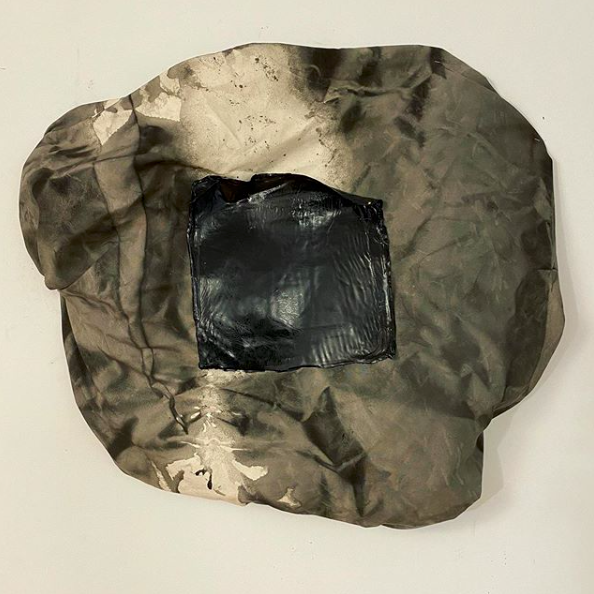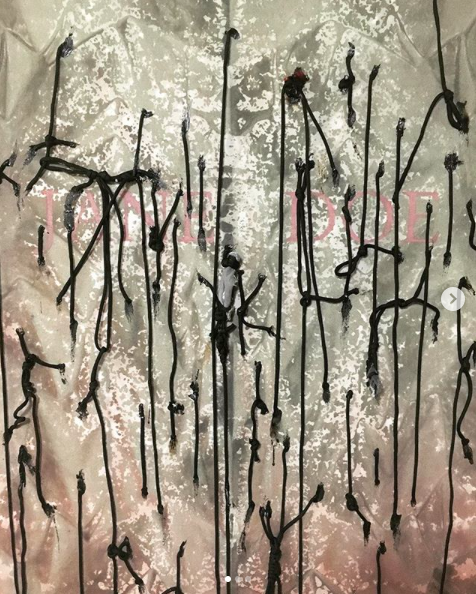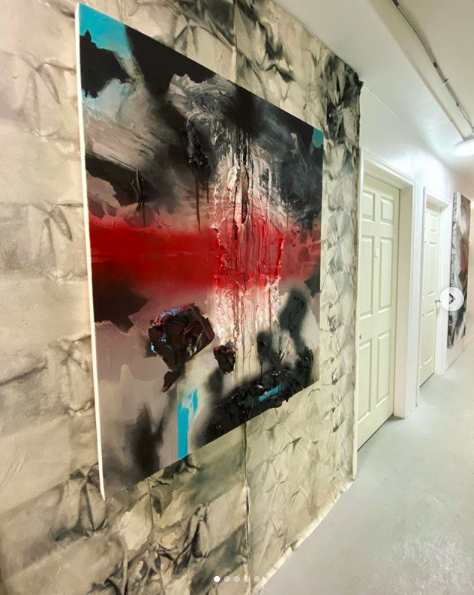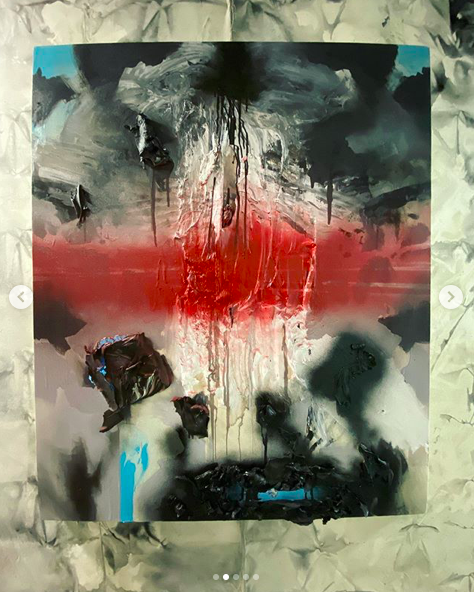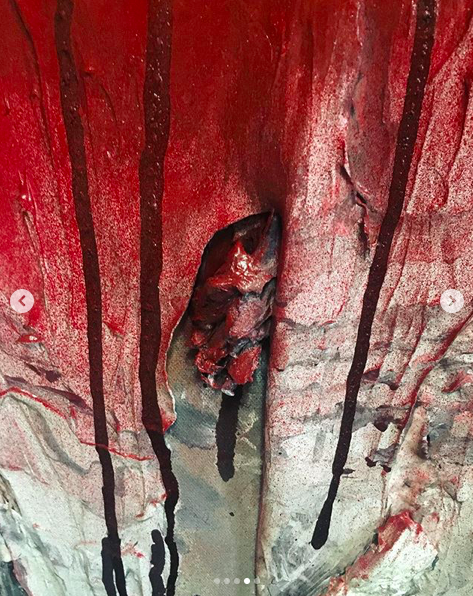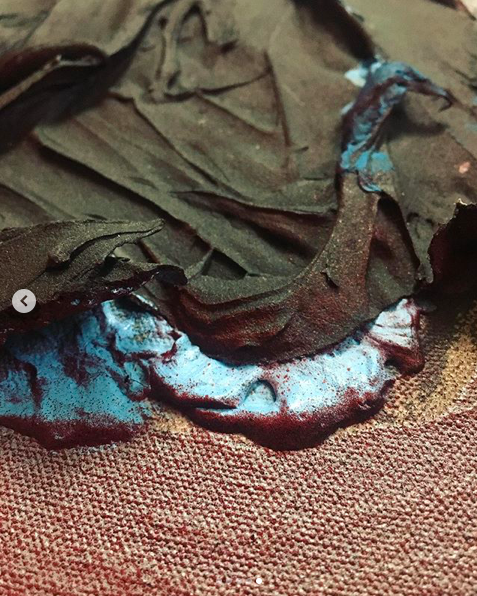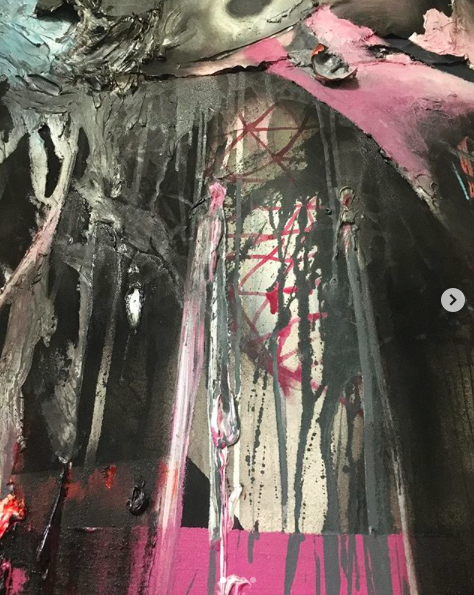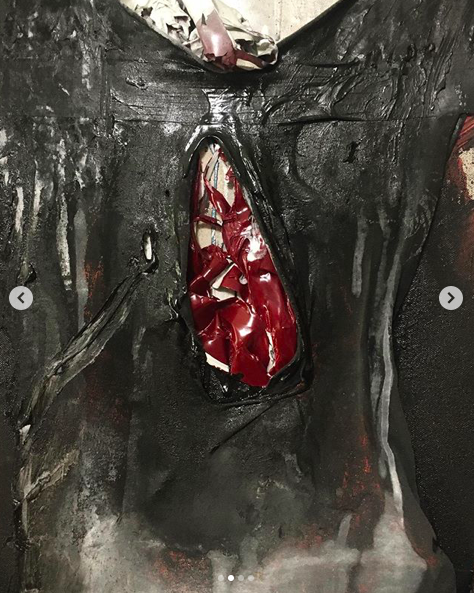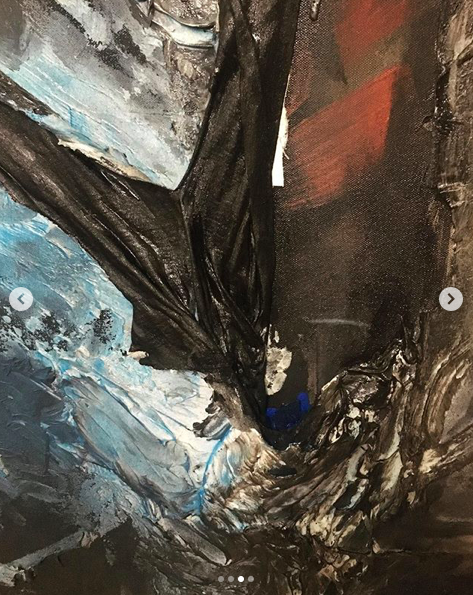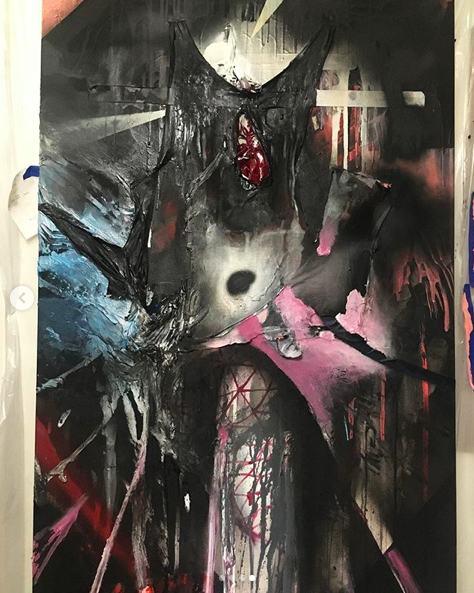Interview with Wayne Marcelli
Interview with
Wayne Marcelli
February 2020 Digital Resident
“I make work about shelter and the apocalypse for the ways these concepts evoke ideas of protection, destruction, and power struggles. My practice is focused around two-dimensional painting but incorporates a variety of interpretive painting methods, from the construction of tent-like structures of canvas, to visual text loosely based in signage, to wooden armatures strewn with paint skins reminiscent of the damaged body. The confrontational nature of this work is echoed through material manipulation (the stapling, ripping, and suturing of paint and fabric) which serves as a reference to destruction and the necessary defenses which destruction calls for.
As a whole my work describes a situation of anxiety. This anxiety, shaped by fears of physical violence, can be thought of as a response to social unrest guided by political spectacle, frenzied media coverage, unpredictable spree shootings, and so on ad nauseam.
As a defense mechanism, anxiety seeks to direct us away from danger to a place of relative safety (flying in the face of strategies like Stand Your Ground and Shelter In Place). In practice, the source of anxiety is often unclear despite the physical toll it can take, suggesting that safety is relative and tenuous, that safe places are a privilege, not a given. Underlying this body of work is a fear that safety may not actually exist at all.
Paint handling is crucial to communicating this nervous energy. The visual language of paint can vary greatly depending on intention, sometimes functioning as wound (Untitled [pull]), other times as a vehicle for written language (Untitled [Sorry Saint]). Text in this way operates as a reference point, a key by which to read the larger compositions, giving viewers a means to enter the abstract with some sense of context (though it may be composed of seeming non sequiturs). Language almost always fails to accurately describe emotional or physical states, analogous to the way abstraction will almost always fail to absolve the artist (and viewer) of their anxieties.
One may interpret this tone as not necessarily an optimistic one, but the artist’s inclination to observe and comment on social traumas is dark work by nature. For me, it’s within this exploration that some psychological equilibrium can be reached. Through this, viewer and artist alike may locate some common ground on which to find solace.”
-Wayne Marcelli
Mineral House Media: Tell us a little bit about yourself and your background in art.
Wayne Marcelli: I went to an arts magnet school for 11th and 12th grade which was the first time I’d ever really painted. Before that it was all violent comics and drawing in textbooks. Painting felt right so I took a bunch of portrait and figure painting classes in undergrad at Coastal Carolina University (2010). It took a few years to realize I actually hated painting representationally (just use a camera) so everything from grad school onward (University of North Carolina 2017) has been real pared down and muted (and angsty).
MHM: How has your engagement with materials evolved over time?
WM: I might still be painting like a purist had I not analyzed my tendencies in grad school. I had some really stellar committee members who could sort of visualize the work I WANTED to be making and pushed me in that direction. That shakeup included playing with new materials, which felt like novelty at first, but was crucial for me to see that my visual language had been stunted by disregarding more sculptural ways of working.
Untitled (Jane Doe). Acrylic, spray paint on canvas. 6'x3'. image from the artist’s website.
MHM: Are you reading or watching anything that inspires your current practice?
WM: I’m reading a book called The Search for the “Manchurian Candidate” which outlines all the wacky and unethical shit the CIA pulled while trying to develop brainwashing techniques. Like dosing unwitting people with LSD and doing electroshock experiments on patients in a mental hospital. With taxpayer money! That’s inspiring, in a please-stop-the-ride sort of way.
MHM: In sharing your processes for handling your art and your approach to materials, you seem to have an open aversion to the default fragility/archivability fixation in art. Bearing in mind that you frame your work in terms of the apocalypse or social collapse, what are your thoughts on preciousness and permanence in art?
WM: This is always tough to consider. On the one hand, I dwell on the unfixed nature of assigning monetary value to subjective things like works of art--who decides? What is an artist’s wage? Couldn’t tell you. On the other hand, I want to sell my work. Spoiler: I rarely do. On yet another I can’t ignore the Accelerationist in me who wants to torch museums and pilfer private collections and sell them off to fund The Revolution. (Settle down FBI, it’s called hyperbole)
Untitled (red dot). Acrylic, latex, spray paint, cable ties, canvas. 4'x3'. image courtesy of the artist.
MHM: How do you paint “nervous energy”? Tell us more about the style of your mark-making, and your thoughts on the role of anxiety overall.
WM: Anxiety is one of my favorite subjects. All my favorite people are anxious as fuck. Nervous energy is not something you can direct, it’s more of a happenstance way of working where you create a new problem for yourself (using fabric, or patterning, or a latex halloween mask, or anything unfamiliar) and fight with it until you come to some resolution (hopefully one that feels fulfilling and visually engaging). I think this is the opposite of working serially, where you might have a concept and make 20 paintings about it, I could never work that way (and maybe that means commercial unviability, TBD).
MHM: Despite the violent action you deploy in making (ripping, melting, stapling, smearing), do you find your work to be personally healing?
WM: Absolutely, if I’m doing it well. I think simulated violence is a misunderstood facet of our culture. Violent video games and movies, death metal, true crime, even *gasp* BDSM--the usual suspects--are (in my limited life experience) not correlated to actual interpersonal violent tendencies. These arenas allow for morally sound people to explore what it might be like to enact violence, not because they necessarily want to harm anyone but to scratch a curiosity itch, which in my humble opinion is about as cathartic (and safe) as it gets. Of course there are violent outliers hidden among us which is why I advocate the buddy system.
Untitled (Sorry Saint). Acrylic, latex, spray paint on canvas. 5'x2.5'. image from the artist’s website.
MHM: You use some religious wording in your text-based pieces (“martyr,” “saint”). How do you feel these themes connect to your overarching concepts of sensationalism, apocalypse, power, and so on?
WM: I have a vivid memory of being in Sunday school around age 7 and learning about Hell for the first time. I went screaming and crying to my parents because I hadn’t yet gone through Confirmation or Communion and was sure that I was going to burn eternally for it. At the same time I was terrified of the priest, his wafers, the confessional, etc. and didn’t ever want to participate. You see the problem here? Raising children in that environment is problematic. I have been unable to shake those roots so I whisper about them in paintings. I’ve heard that the patriarchy is so insidious because you don’t know how deeply you’ve been infected by it. And nothing is more patriarchal to me than Catholicism with its multitude of Fathers.
MHM: Can you describe what safety feels like to you?
WM: Fleeting. Fluid. Highly conditional. Privileged. Having enough money in your checking account to buy another month’s rent. Then what?
Untitled (tank top). Acrylic, latex, plywood, found t-shirt. 5'x3'. image courtesy of the artist.
MHM: You occasionally post videos of yourself lifting very heavy weights. Do you think your approach to athleticism informs your approach to the body as a motif in your work?
WM: I genuinely laughed at this. It’s not something I’ve ever tried to connect to artmaking. But since you asked, I think both practices relate to a general dysphoria about occupying a body, a specific body with its limitations and all the myriad ways we’re convinced to hate it for not looking a certain way. It’s paradoxical but lifting is the only way I know to mute that inner monologue. And I think painting functions as a channel to acknowledge it, poke at it, reveal facets of it to other people. Because talking about hating your body as a healthy able-bodied male, I don’t know, nobody wants to hear that shit.
I think if I were to design a personalized hierarchy of needs, the two would share a row.
MHM: What role does humor play in your practice?
WM: I don’t think the work itself is very humorous but I try to have fun with it to take some of the pressure off of making something (what if it sucks?). Especially when I’m obsessing over an idea and it has the potential to become troubling (in the intrusive thought sense), so I end up painting a castration scene. Or something that looks like it’s been burned to death. It’s funny because it’s horrifying. Nervous laughter.
MHM: You implement a lot of black and neutral fields in your work. How do you go about choosing moments of color?
WM: These questions are so good. Color is difficult for me to use, I feel like it has to be super deliberate because of all the associations we make with different colors. I use a lot of pink and blue for their genderedness, and lots of red for its obvious bodily association but also to refer to rage, warning, threat etc. Because I use so much black and grey these little flecks of color become supercharged. I feel bad if I don’t use color responsibly. You can’t have it all, ok? God.
MHM: What does neon light symbolize to you?
WM: Dark places lighted with neon, these are the spaces in which unorthodox thinking happens, or where it becomes acceptable to entertain transgressive modes of being, like throwing secret raves in abandoned buildings, or crossdressing for fun, or asking “what if demons are real and you can only see them after ingesting psilocybin?” Neon light allows the unconscious to leech through, whereas bright floodlights scare it away. I think.
Untitled (pile). Latex paint, canvas. 3'x3'x1'. image courtesy of the artist.
MHM: What kind of art would you make in a post-apocalyptic situation? If you had to choose 3 art supplies to work with in this scenario, what would they be?
WM: I don’t want to survive the apocalypse tbh. What would I do without the internet and a coffee maker and air conditioning? Kill me. Ok but if I had to choose, steel, charcoal, and sandpaper. Then I’d build a forge and make knives and trade them for faux fur pelts. Oh and eyeglasses because my vision is terrible and you know you’d be scratching lenses left and right in the apocalypse.
MHM: Does your environment affect your work? Or what is your ideal workspace?
WM: My ideal workspace is not a 12x12 guest room. A disused aircraft hangar that I share with my bff @radvalleydesigns. It’s got a fully equipped wood shop and a fridge of seltzers. Coconut please, keep the Pamplemousse. Also doubles as a techno dance party spot.
Oh in this fantasy world I also have a steady income! Dreaming is nice.
MHM: Who are some of your favorite artists?
WM: I unabashedly idolize the work of Gail Stoicheff. I’m also keen on Jenny Holzer, Francis Bacon, and that Dora Maar photo of the armadillo or pangolin or whatever it is. Oh and the Urs Fischer melty people.
MHM: What’s next in the studio? Can we see your work anywhere in person?
WM: I’m finishing work for a show at the FAB Gallery at SC State University. It opens Monday 3/16/2020 and I’m going to coolly step away from the keyboard now and carry on like I have plenty of time to wrap things up. Everything is totally OK.
And thank you for the fantastic interview. Mineral House Media is fucking fabulous (sorry/not sorry for the profanity). <3
Wayne Marcelli was born in 1987 in Wappingers Falls, New York. A 2017 MFA graduate from UNC Chapel Hill, Marcelli’s practice is painting-focused and deals with themes like waste, destruction, and the body. He lives and works outside of Chapel Hill, NC with his partner Allison and about a thousand cats.
